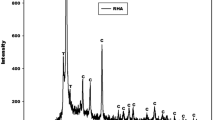Abstract: Silica bricks with cemented silica and crystalline silica as raw materials show different properties. In this paper, the phase and structural characteristics of different kinds of silica raw materials and silica bricks after heat treatment at different temperatures are explored by the means of XRD, SEM and CT, and the formation mechanism of tridymite in the silica bricks is clarified. Results show that the liquid phase formed by impurities in both crystalline silica and cemented silica raw material cannot promote the transformation of quartz to tridymite at high temperatures. The phase composition of both cemented silica and crystalline silica after heat treatment at 1460 and 1550 °C is cristobalite.













Similar content being viewed by others
References
Zhang F M, Mao Q W, Mei C H, et al. Dome combustion hot blast stove for huge blast furnace[J]. Journal of Iron and Steel Research, International, 2012, 19(9): 1-7.
Arahori T, Suzuki T. Transformation of tridymite to cristobalite below 1470°C in silica refractories[J]. Journal of Materials Science, 1987, 22(6): 2248-2252.
Ashworth J R. Transformation mechanisms of tridymite to cristobalite studied by transmission electron microscopy[J]. Physics and Chemistry of Minerals,1988,15(3): 246-251.
Elzea J M, Rice S B. Tem and X-Ray diffraction evidence for cristobalite and tridymite stacking sequences in opal[J]. Clays and Clay Minerals, 1996, 44(4): 492-500.
Nabil M, Mahmoud K R, El-Shaer A, et al. Preparation of crystalline silica (quartz, cristobalite, and tridymite) and amorphous silica powder (one step)[J]. Journal of Physics and Chemistry of Solids, 2018, 121(3): 22-26.
Smith, Deane K. Opal, cristobalite, and tridymite: Noncrystallinity versus crystallinity, nomenclature of the silica minerals and bibliography[J]. Powder Diffraction, 1998, 13(01): 2-19.
Yajie Dai, Yucheng Yin, et al. Effect of the phase transformation on fracture behaviour of fused silica refractories[J]. Journal of the European Ceramic Society, 2018, 38(16): 5601-5609.
Ilkhechi N N, Kaleji B K, Mozammel M, et al. Effect of Cu and Zr Co-doped SiO2 nanoparticles on the stability of phases (quartz-tridymite-cristobalite) and degradation of methyl orange at high temperature[J]. Silicon, 2017, 9(2): 293-299.
Arrnrxo N. Three tridymite structural modifications and cristobalite intergrown in one crystal[J]. American Mineralogist, 1987, 72: 167-169.
Pilate P, Lardot V, Cambier F, et al. Contribution to the understanding of the high temperature behavior and of the compressive creep behavior of silica refractory materials[J]. Journal of the European Ceramic Society, 2015, 35(2): 813-822.
Brunk F. Silica refractories[J].International Ceramic Review, 2001, 5: 27-30.
Lemmens H, Czank M, Tendeloo G V, et al. Defect structure of the low temperature α-cristobalite phase and the cristobalite-tridymite transformation in (Si-Ge)O2[J]. Physics and Chemistry of Minerals, 2000, 27(6): 386-397.
Monica D, Lucia P, Alessandro P, et al. The formation of silica high temperature polymorphs from quartz: Influence of grain size and mineralising agents[J]. Journal of the European Ceramic Society, 2015, 35(16): 4547- 4555.
German R M, Suri P, Park S J. Review: liquid phase sintering[J]. Journal of Materials Science, 2009, 44(1): 1-39.
Manivasakan P, Rajendran V, Rauta P R, et al. Effect of TiO2 nanoparticles on properties of silica refractory[J]. Journal of the American Ceramic Society, 2010, 93(8): 2236-2243.
Peters T, Iberg R, Mumenthaler T. Comparative study of the use of a quartz poor sand and a pure quartz sand for lime silica bricks and the kinetics of the hydrothermal hardening mechanism[J]. Cement & Concrete Research, 1978, 8(4): 415-424.
Taylor N W, Yuan C L. Effect of various catalysts on conversion of quartz to cristobalite and tridymite at high temperatures[J]. Journal of the American Ceramic Society, 1941, 24(2): 57-63.
Richet P, Bottinga Y, Denielou L, et al. Thermodynamic properties of quartz, cristobalite and amorphous SiO2: drop calorimetry measurements between 1000 and 1800 K and a review from 0 to 2000 K[J]. Geochimica Et Cosmochimica Acta, 1982, 46(12): 2639-2658.
Mitra, Sanmoy. Kinetics of quartz transformation[J]. Transactions of the Indian Ceramic Society, 1974, 33(3-4): 25-38.
Moroz I K, Maslennikova G N, Mironova A F, Platov Y P. Formation of tridymite and cristobalite from quartz in porcelain[J]. Glass and Ceramics, 1980, 37(3): 147-150.
Author information
Authors and Affiliations
Rights and permissions
About this article
Cite this article
Zhang, Xh., Li, Y., Tian, Zh. et al. Transformation Mechanisms of Cemented Silica and Crystalline Silica to Tridymite in Silica Bricks. Interceram. - Int. Ceram. Rev. 71, 20–29 (2022). https://doi.org/10.1007/s42411-022-0505-0
Published:
Issue Date:
DOI: https://doi.org/10.1007/s42411-022-0505-0




